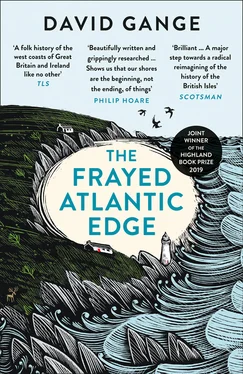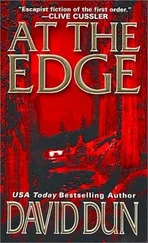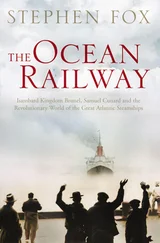The first challenge was Fitful Head. Yet again, the wind was low as I reached a point where any breeze would have spelled trouble, and yet again, this was enough to draw the sting from a possible threat. I bounced fast enough through the tidal overfalls at the Head to consider tackling the second challenge before dark. But Sumburgh Head was worth waiting for: it offered the possibility of whales and the chance to see one of Britain’s most spectacular tidal runs, da roost , in action.
As the sun rose over another subdued sea – the fading swell preserving the memory of long-departed breezes – I launched. Porpoises, closer than any I’d seen so far, edged along the coast ahead. I soon passed the largest stretch of sand on Shetland. There is no hint when paddling past that this was once the thriving village of Broo. Landowners and tenants in the early eighteenth century began to note deterioration in the quality of their land. Soon, it was ‘declared valueless’. By the mid-eighteenth century, the once-wealthy village had been obliterated beneath ‘a small dusty kind of sand, which never possibly can rest, as the least puff of wind sets it all in motion, in the same manner as the drifting snows in winter’. 16Caused by the climatic cooling of Europe’s ‘little ice age’ (the 1690s were one of the coldest decades in the last millennium), this tragedy was the most dramatic evidence I had seen so far of the scale and unpredictability of transformation on these coasts.
Passing this eerie site, I soon found myself sandwiched between tides, and forced to make split-second decisions about my route. At the first asking, I got it wrong, choosing not to go round the island of Horse Holm but to tackle the straits between the island and the mainland. This felt like taking a bike without suspension down a steep road of huge cobbles: the powerful tide was with me, but at times I was afraid the huge overfalls might bury or even break the kayak. My spare paddle was strapped to my deck in two pieces, but it was clear, as overfalls wrenched at the one I held, that a second without a paddle would be disastrous. I’m frequently surprised by how short these infamous tidal runs tend to be: I thought I was at the start of a long and harrowing ordeal when I found myself spat out into placid water. After this, Sumburgh Head itself was straightforward. The sun appeared as I made my way out to sea, south of the whole of Shetland, and for the first time in my journey I could see people gazing down, bird-watching binoculars raised to assess the small yellow form scraping across the sea. They were there in numbers, I soon discovered, looking for orcas that had been sighted the previous day.
I landed at the launch of the tiny Fair Isle ferry and crossed the narrow neck of land behind Sumburgh Head. This took me to a spot rich in historic remains, including Shetland’s most dramatic Viking tourist-draw: Jarlshof. The Norse traditions of this southern tip of Shetland are nearly as rich as those of Unst. Even the tidal stream I’d just swept through is rich in story. The Orkneyinga Saga is a tale of competition between Norwegian earls for the coasts and archipelagos of the North Atlantic; like most such sagas it is gripping and evocative but fiercely elitist, with barely a glimpse of perspectives beyond those of its entitled male protagonists. In 1148, the saga says, Earl Rognvald Kali Kolsson, ruler of the Northern Isles, was travelling between Orkney and Norway. With breakers all around, he was forced to run ashore at the south of Shetland. Rognvald wandered local settlements, enjoying anonymity and frequently (as was his habit) breaking into verse. One day, he met a poor elderly man near Sumburgh Head. Learning that the man had been let down by a rowing companion, Rognvald (disguised in a white cowl) offered to help him fish. The two rowed out to Horse Holm making for the ‘great stream of tide … and great whirling eddies’ that I’d just swept along. As the old man fished, Rognvald’s task should have been to skirt the tidal stream by rowing the boat against the eddies. Instead, he guided them deep into the turbulence where the fisherman began to draw up enormous fish, but soon cried out in terror ‘Miserable was I and unlucky when I took dee today to row, for here I must die, and my fold are at home helpless and in poverty if I am lost.’ Shouting ‘Be cheerful man!’, Rognvald rowed like a man possessed, eventually drawing them clear of the chaos and back to shore. Still incognito, he gave his share of the catch to the women and children preparing the fish on land, but then slipped on the rocks, provoking howls of mocking laughter. Rognvald muttered one of his verses, rendered here by the Orkney poet George Mackay Brown:
You chorus of Sumburgh women, home with you now.
Get back to your gutting and salting.
Less of your mockery.
Is this the way you treat a stranger?
Think, if this beachcomber
Hadn’t strayed to this shore by chance
Your dinner tables
Would be a strewment of rattling whelkshells today.
Sumburgh women, never set staff or dog or hard word
On the tramp who stands at your door
It might be an angel,
Though here, with the Sumburgh querns grinding salt out there,
It was only a man in love with the sea,
Her beauty, her rage, her bounty,
One who knows that, all masks being off,
In heaven’s eye
Earl is no different from a pool-dredging eater of winkles.
‘They knew then’, Mackay Brown writes,
that the reckless benefactor was Earl Rognvald Kolson (nephew of St Magnus), one of the rarest most radiant characters in Norse history. A fragrance and brightness linger about all Rognvald’s recorded doings and sayings, as if the long sun of northern summers had been kneaded into him. 17
But da roost and Rognvald’s antics are unusual: old stories tied to Shetland landscapes are few, and documentation of Shetland’s early history is far sparser than that for other parts of Britain. From the centuries when much of the landscape would have been named we receive only the barest skeleton of events. The Orkneyinga Saga says that Shetland was split from Orkney in the 1190s after a rebellion of the ‘Island-Beardies’ (as Orcadians and Shetlanders apparently called themselves). From then on, Shetland was largely left to its own devices, although it changed hands (from Norway to Scotland) in 1469. Only when the conditions of medieval Shetland began to collapse, in the dire economic circumstances of the late sixteenth century, are there detailed written records of what life here might have been like: bitter complaints at the loss of order and well-being. By this point, Shetland was an exceptionally cosmopolitan place, the islands frequented by merchants from around Europe and the North Atlantic, so that Shetlanders often spoke some German and Dutch as well as their own Norn language.
The reason for the dearth of early Shetland stories is the eighteenth-century death of Norn. In literary terms, this loss was total: remarkably, no Norn literature survives except in second-hand fragment. Yet Shetland’s dialect tradition is a worthy successor to the Norn heritage and a key impetus behind the wealth of current literature. This is undoubtedly the richest dialect in Britain and a constant presence in the experience of visitors (few, I imagine, leave Shetland without succumbing to the temptation to call small things ‘peerie’ or to replace ‘th’s with ‘d’s and ‘t’s). It is among Shetland’s greatest assets and the source of much of the archipelago’s distinctiveness.
Once Norn died, dialect flourished. The nineteenth century has an awful reputation where dialect traditions are concerned: the bureaucratisation and centralisation of British life led many autocrats to think like Thomas Hardy’s mayor of Casterbridge, who labelled dialect words ‘terrible marks of the beast to the truly genteel’. Yet Shetland bucked the trend, forging – as always – a path all its own. By 1818, the crofters visited by Samuel Hibbert used words and grammatical constructions substantially the same as those employed by Shetlanders today (although, as the Shetland archivist Brian Smith puts it, ‘naturally, the vocabulary is different, since we live in a society where dozens of words for small-boat equipment or seaweed, are unnecessary’). But the 1880s and 90s, during which Shetland crofters and fishers were freed by national legislation from the worst exploitation of landlords, marked a particular moment of growth. The first Shetland newspapers were founded in 1872 and 1885, and both specialised in dialect prose. They ran long serials such as ‘Fireside Cracks’ ( Shetland Times , 1897–1904) and ‘Mansie’s Rüd’ ( Shetland News , 1897–1914) which used island language to offer subtle observations of island life. ‘My inteention’, says the narrator of ‘Mansie’s Rüd’, ‘is no sae muckle ta wraet o’ my warfare i’ dis weary world, as to gie some sma’ account o’ da deleeberat observations o’ an auld man, on men an’ things in a kind o’ general wye.’ As this suggests, these columns were not inward-looking things, but helped form distinctive island perspectives on the world at large. In this newly prolific era, Shetlanders such as Laurence Williamson began collating and categorising dialect words and phrases, while others, such as the Faroese linguist Jakob Jakobsen, began to attempt to recover the old Norn language.
Читать дальше












